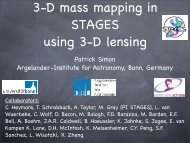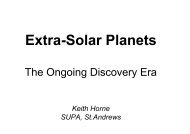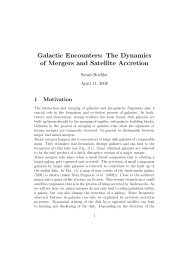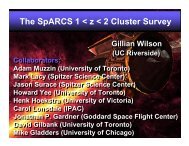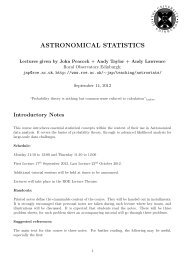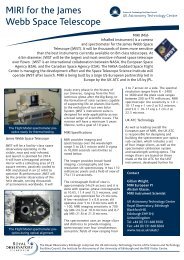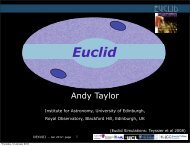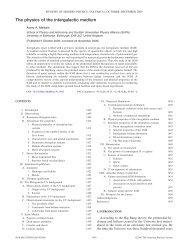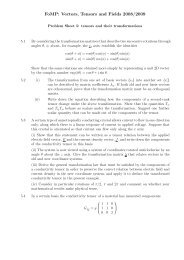Physical Characterisation of the Binary EKBO 2001 QT297
Physical Characterisation of the Binary EKBO 2001 QT297
Physical Characterisation of the Binary EKBO 2001 QT297
Create successful ePaper yourself
Turn your PDF publications into a flip-book with our unique Google optimized e-Paper software.
Draft<br />
Mass, Size, Albedo:<br />
Using <strong>the</strong> current best estimates <strong>of</strong> orbital period and semi-major axis, we derived a system mass<br />
<strong>of</strong> ~3.2x10 18 kg (while <strong>the</strong> uncertainties for <strong>the</strong> period and semi-major axis estimates are still<br />
large, <strong>the</strong>y are correlated such that each feasible fit provides a similar system mass with an<br />
uncertainty <strong>of</strong> about +0.3x10 18 and –0.2x10 18 kg). Fur<strong>the</strong>r adopting a mean magnitude difference<br />
between <strong>the</strong> two binary components <strong>of</strong> ~0.8 magnitudes and similar albedo and density values for<br />
<strong>the</strong> two bodies, we derived a mass ratio for <strong>the</strong> components <strong>of</strong> just over 3. Given <strong>the</strong> system<br />
mass and component mass ratio, we estimate size and albedo <strong>of</strong> <strong>the</strong> binary components under two<br />
plausible density conditions. First, assuming a density similar to that <strong>of</strong> Pluto (~2.0 g/cm 3 ) we<br />
estimate <strong>the</strong> radius <strong>of</strong> <strong>the</strong> primary to be 78 km and that <strong>of</strong> <strong>the</strong> secondary to be 54 km with an<br />
albedo <strong>of</strong> 14%. At ano<strong>the</strong>r extreme for a solid body, we assumed a density <strong>of</strong> 1.0 g/cm 3 (for a<br />
composition <strong>of</strong> primarily water ice) and estimate primary and secondary radii <strong>of</strong> 98 and 68 km<br />
respectively with an albedo <strong>of</strong> 9%. Table 3 provides a comparison <strong>of</strong> <strong>the</strong> physical properties <strong>of</strong><br />
<strong>2001</strong> QT_297 with those <strong>of</strong> <strong>the</strong> o<strong>the</strong>r EKO binary objects with known parameters, Pluto-Charon<br />
and 1998 WW_31. Of primary interest is <strong>the</strong> fact that <strong>the</strong> <strong>of</strong>t adopted EKO albedo estimate <strong>of</strong><br />
4% (based on measurements for a handful <strong>of</strong> cometary nuclei) does not appear a representative<br />
value for objects in <strong>the</strong> EKB unless in <strong>the</strong> unlikely case that <strong>the</strong>ir bulk densities are far lower than<br />
that <strong>of</strong> pure water ice. Additional evidence for <strong>the</strong> general inapplicability <strong>of</strong> cometary nuclei<br />
albedo values to EKOs is found in combined visible and sub-mm observations <strong>of</strong> a handful <strong>of</strong> <strong>the</strong><br />
largest EKOs (eg. Jewitt et al., <strong>2001</strong>).<br />
Table 3. EKO <strong>Binary</strong> Characteristics.<br />
<strong>Binary</strong> Period (days) Semi-major axis (km) Radius (km) Albedo<br />
Pluto-Charon 1 6.38726±0.00007 19,636 ± 8 1175 ± 25<br />
625 ± 25<br />
0.44-0.61<br />
0.38<br />
1998 WW_31 2 574 +/- 10 22,300 +/- 800 118 & 98 a<br />
148 & 123 b 0.09<br />
0.07<br />
<strong>2001</strong> QT_297 876 +/- 227 31,409 +/- 2500 78 & 54 a<br />
98 & 68 b 0.14<br />
0.09<br />
1 Tholen & Buie 1997 and references <strong>the</strong>rein 2 Veillet et al., 2002<br />
a density=2.0 g/cm 3 b density=1.0 g/cm 3<br />
Continued resolved astrometric observations <strong>of</strong> <strong>2001</strong> QT_297 will allow us to refine <strong>the</strong> orbit<br />
parameters leading to a more accurate and precise mass determination for <strong>the</strong> system. Combined<br />
with accurate size and albedo estimates derived from simultaneous (or appropriately phased)<br />
visible observations <strong>of</strong> <strong>the</strong> individual components with <strong>the</strong>rmal observations <strong>of</strong> <strong>the</strong> system with<br />
SIRTF, we will be able to uniquely determine <strong>the</strong> bulk density <strong>of</strong> this binary pair. Similar<br />
combinations <strong>of</strong> simultaneous visible and <strong>the</strong>rmal observations <strong>of</strong> EKOs should soon lead to<br />
accurate estimates <strong>of</strong> size and albedo for a statistically significant sample <strong>of</strong> <strong>the</strong>se bodies as well<br />
as additional density estimates for <strong>the</strong> growing number <strong>of</strong> discovered binary systems.<br />
This work was supported, in part, by NSF Grant AST99-77535 and NASA Grant NAG5-10444.



